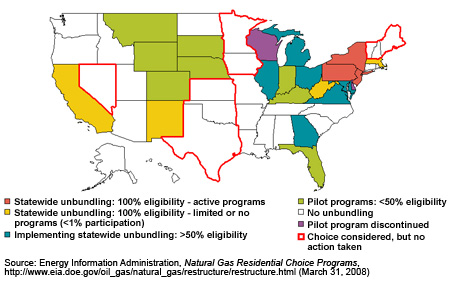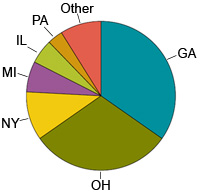
Large commercial and industrial consumers have had the option of purchasing the natural gas commodity separately from other natural gas services for many years.
As of December 2007, 21 States and the District of Columbia Had Legislation or Programs Allowing Residential Customer Choice

How Choice Programs Work
Customer choice programs give consumers the option of purchasing natural gas from an unregulated supplier (marketer) rather than a local utility company. If a consumer chooses to buy from a marketer, the marketer purchases the natural gas and arranges for its delivery to the local utility. The local natural gas utility, generally referred to as a local distribution company or LDC, continues to provide local transportation and distribution services. Local distribution companies are regulated by State utility commissions and cannot earn a profit on natural gas sales, whereas sales by marketers are unregulated.
Most natural gas customer choice programs began in the 1990s in an effort to introduce more competition into local energy markets. Traditionally, local distribution companies provide natural gas to their customers as part of a bundled service that includes both the price of the natural gas (sometimes called sales service) and the price of distributing the gas. In customer choice programs, gas sales are unbundled from distribution and other delivery-related services.
The characteristics and availability of existing choice programs vary markedly. Some States allow all customers to choose, while some limit choice to specific service areas or a specific number of customers. In some cases, even though choice is allowed statewide, no programs are being offered or no marketers are participating.
Choice Enrollment Reached a New High in 2007
Overall 13% or about 4.6 million of the approximately 35 million residential natural gas customers with access to choice (55% of U.S. residential customers) were buying natural gas from marketers in 2007, up from 4.2 million in 2006. Enrollment totaled 11% more than in 2006 and 20% more than in 2005, although the number of States allowing choice has remained the same since 2002.
Georgia has by far the most comprehensive choice program, in that all residential customers in Atlanta Gas Light Company’s service territory (more than 80% of Georgia’s residential gas customers) purchase their natural gas from marketers. Atlanta Gas Light still delivers the gas but no longer provides sales service. Ohio has the second-largest program with about 48% of all eligible households participating and enrollment levels of nearly 1.4 million. Together Georgia and Ohio accounted for nearly 65% of the residential customer enrollment total in 2007.
| Six States Accounted for 90% of the Residential Choice Customers in 2007 | |||||||||||||||||||||||||||||||||||||||||||||||||||||||||||||||||||||||||||||||||||||||||
 |
|||||||||||||||||||||||||||||||||||||||||||||||||||||||||||||||||||||||||||||||||||||||||
|
|||||||||||||||||||||||||||||||||||||||||||||||||||||||||||||||||||||||||||||||||||||||||
| Source: Energy Information Administration, Natural Gas Residential Choice Programs, http://www.eia.doe.gov/oil_gas/natural_gas/restructure/restructure.html (March 31, 2008) | |||||||||||||||||||||||||||||||||||||||||||||||||||||||||||||||||||||||||||||||||||||||||
Customer participation is determined by a variety of factors, such as the customer’s potential to save money and the terms of service. In the same way, marketers’ participation is influenced by the potential to earn a profit on natural gas sales. In 2007, 120 marketers were authorized to serve residential customers, of which 91 were actively serving customers. Many marketers have expanded their price offerings to attract customers. Besides month-to-month variable rates or fixed rates for longer terms, some marketers offer introductory rates, rebates, budget plans, or capped rates.
Despite Increase, Interest Is Lower in Several States
Participation in customer choice has declined in several States with long-standing programs. Some customers may find it hard to tell which choice option would be best for them and whether they will save any money. In addition, sharply higher natural gas prices and increased price variability may have reduced consumer and marketer interest in choice. State regulators are continuing to refine and evaluate choice programs to ensure supply reliability and make it easier for consumers to compare price offers.
